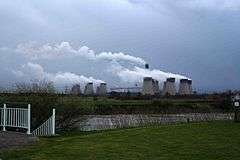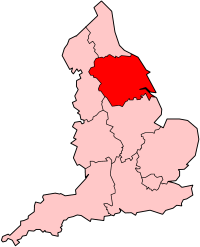Drax Group
 | |
| Public (LSE: DRX) | |
| Industry | Electrical power generation |
| Founded | 2005 |
| Headquarters | Drax, North Yorkshire, England |
Key people |
Phil Cox CBE, Chairman Dorothy Thompson, Chief Executive |
| Products | Electrical power and byproducts of power product |
| Revenue | £3,065.0 million (2015)[1] |
| £76.0 million (2015)[1] | |
| £56.3 million (2015)[1] | |
| Website | www.drax.com |
Drax Group plc is a British electrical power generation company that specialises in renewable, reliable, affordable energy. The Group is made up of upstream and downstream enterprises. The principal downstream enterprises are based in the UK and include Drax Power Limited, which runs Europe’s biggest biomass-fuelled power station, Drax power station, near Selby in North Yorkshire – the UK’s largest decarbonisation project, as well as supplying between 7-8 per cent of the country’s electricity needs. Related businesses include Haven Power, a supplier of electricity (including sustainable biomass energy) to business, and Billington Bioenergy, a supplier of sustainable wood pellets for domestic biomass energy systems. The group’s largest upstream enterprises are Drax Biomass, which sources sustainable biomass for Drax power station and Baton Rouge Transit, which handles storage and transport of finished biomass pellets from the Port of Baton Rouge, Louisiana.
The company is listed on the London Stock Exchange and is a constituent of the FTSE 250 Index.
History
In 1990, the electricity industry of England and Wales was privatised under the Electricity Act 1989. Three generating companies and 12 regional electricity companies were created. As a result of privatisation, Drax Power Station came under the ownership of National Power, one of the newly formed generating companies. Over the years that followed privatisation, the map of the industry changed dramatically. One significant change was the emergence of vertically integrated companies, combining generation, distribution and supply interests. In certain cases, it became necessary for generation assets to be divested, and so in 1999 Drax Power Station was acquired by the US-based AES Corporation for £1.87 billion (US$3 billion).[2] A partial re-financing of Drax was completed in 2000, with £400 million of senior bonds being issued by AES Drax Holdings, and £267 million of subordinated debt issued by AES Drax Energy.[3]
Increased competition, over-capacity and new trading arrangements contributed to a significant drop in wholesale electricity prices, which hit an all-time low in 2002. Many companies experienced financial problems, and Drax Power Station’s major customer went into administration, triggering financial difficulties for Drax. Following a series of standstill agreements with its creditors, the AES Corporation and Drax parted company in August 2003.[4] During the restructuring, a number of bids were received from companies wishing to take a stake in the ownership of Drax, but creditors voted overwhelmingly to retain their interest in Drax. In December 2003, the restructuring was completed and Drax came under the ownership of a number of financial institutions.[5]
Almost exactly two years later, on 15 December 2005, Drax underwent a re-financing and shares in Drax Group plc were listed on the London Stock Exchange for the first time.[6]
In 2009, Drax Group acquired Haven Power [7] – enabling it to sell electricity directly. In 2015, the Group acquired Billington Bioenergy, specialists in providing sustainable biomass pellets for domestic energy systems.[8]
Drax Power Station

Drax Group’s key asset is Drax Power Station. Originally built, owned and operated by the Central Electricity Generating Board (CEGB), Drax Power Station was constructed and commissioned in two stages. Stage one (units 1, 2 and 3) was completed in 1974.[9] Some 12 years later in 1986, stage two (units 4, 5 and 6) was completed.[9] Drax was the last coal-fired power station to be built in the UK, and was initially designed to use low-sulphur coal from the nearby Selby coalfield in six generating units. Each unit has a capacity of 660MW when burning coal, giving a total capacity of just under 4,000M. This made Drax the largest power station in the UK.[9]
In 1988, Drax became the first power station to invest in the retrofit of flue-gas desulfurization (FGD) equipment, making Drax the cleanest coal-fired power station in the UK. This removes at least 90 per cent of the sulfur dioxide (SO2) from emissions. Through retrofitting boosted-over-fire-air (BOFA) technology on all the boilers emissions of oxides of nitrogen (NOX) are being further reduced. At the same time, by-products of the coal combustion and FGD processes are recycled through their further use in the construction industry.[9]
In 2012, Drax power station completed a five-year £100 million project – the largest steam turbine modernisation programme in UK history – upgrading its high-pressure and low-pressure turbines. This saves one million tonnes of CO2 a year, which is the equivalent of taking 275,000 cars off the road.[10]
Decarbonisation Project
By 2014, the conversion of the first two generating units at Drax power station from burning coal to burning sustainable biomass had already resulted in carbon savings of more than 2.7 million tonnes of CO2.[11] The power station is already making carbon savings of 86 per cent compared to burning coal[12] –significantly above the European Commission's best practice benchmark of 70 per cent.[13]
White Rose CCS
Drax is leading the way in developing Carbon Capture and Storage (CCS) technology. This is the UK’s largest carbon capture project, and has the potential to radically change the way electricity is generated all over the world, by capturing CO2 at the point of generation. To prove this technology works, Drax is building a full-scale working power station along with its partners in the Capture Power consortium – the White Rose CCS demonstration project.[14]
Related Enterprises
Drax Biomass
Drax Biomass specialises in producing biomass pellets to be used to generate electricity and fuel domestic heating systems by Drax Power Station, Haven Energy and Billington Bioenergy.[15]
Baton Rouge Transit
Baton Rouge Transit is responsible for storing and loading the biomass at the Port of Baton Rouge and for ensuring their safe onward transportation. After being unloaded from truck or train, biomass pellets are stored in the two 40,000 tonne domes at the port. From there, they are loaded onto ships for transport to UK ports at Kingston upon Hull, Immingham, Port of Tyne and Liverpool.[16]
Haven Power
Haven Power is an electricity supplier and part of the Drax Group. The company supplies primarily to commercial and business customers.[17]
Billington Bioenergy
The vast majority of the UK’s tens of millions of homes depend on fossil fuels for their heating, mainly gas but also fuel oil. These energy sources are unsustainable, have question marks over security of supply and produce more carbon dioxide emissions than sustainably sourced biomass over its lifecycle.[18]
References
- 1 2 3 "Annual Report 2015" (PDF). Drax Group. Retrieved 3 April 2016.
- ↑ "AES buys Drax power plant". Global Trade News. 20 October 1999. Retrieved 27 August 2015.
- ↑ "Drax gets high and mighty". IJ Global. 1 September 2000. Retrieved 27 August 2015.
- ↑ "AES withdraws support for Drax restructuring". Global Trade News. 26 August 2003. Retrieved 27 August 2015.
- ↑ "Drax creditors vote to hold on to plant". The Telegraph. 11 December 2003. Retrieved 27 August 2015.
- ↑ "Drax powers ahead with £2.3bn flotation". This is Money. 15 December 2003. Retrieved 27 August 2015.
- ↑ "Drax Group finds a haven". Growth Business. 6 March 2009. Retrieved 27 August 2015.
- ↑ "Drax branches out into renewable heat market with wood pellet firm deal". Incisive Business Media Limited. 5 March 2015. Retrieved 27 August 2015.
- 1 2 3 4 "Drax Power Station". Engineering Timelines. Retrieved 3 April 2016.
- ↑ "Drax Power station in North Yorkshire completes upgrade". BBC. 19 June 2012. Retrieved 27 August 2015.
- ↑ "Drax Group Annual Report and Accounts 2013" (PDF). Drax Group. 18 February 2014. Retrieved 27 August 2015.
- ↑ "The Biomass Story" (PDF). Drax Group. Retrieved 27 August 2015.
- ↑ "Commission Staff Working Document State of play on the sustainability of solid and gaseous biomass used for electricity, heating and cooling in the EU (page 20)" (PDF). European Commission. 28 July 2014. Retrieved 27 August 2015.
- ↑ "UK to build world's first power plant with negative emissions". New Scientist. 15 August 2015. Retrieved 27 August 2015.
- ↑ Gow, David (19 March 2004). "Drax goes green with willow". London: The Guardian. Retrieved 15 August 2009.
- ↑ "New biomass terminal planned for Port of Liverpool". www.worldcoal.com. 29 June 2015. Retrieved 3 September 2015.
- ↑ "Haven Power to provide Thames Water with renewable energy". Herald scotland. 26 May 2015. Retrieved 3 April 2016.
- ↑ "IPCC Special Report on Renewable Energy Sources and Climate Change Mitigation, chapter 9" (PDF). Intergovernmental Panel on Climate Change. May 9, 2011. Retrieved 27 August 2015.
